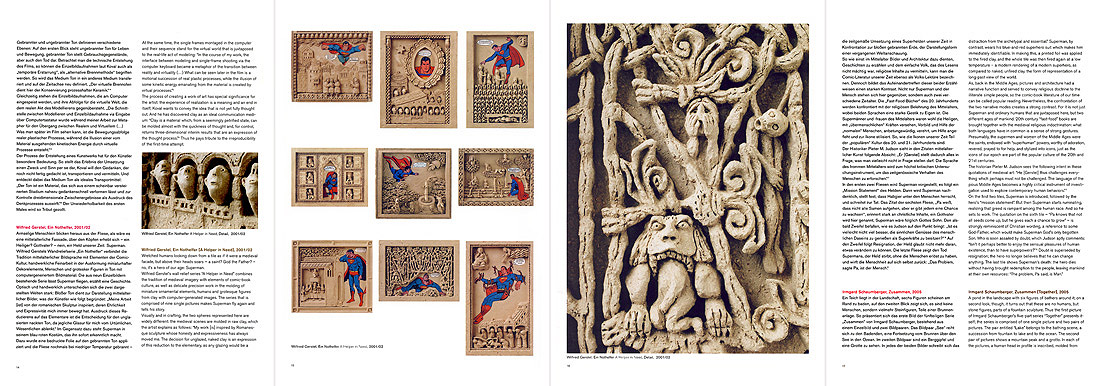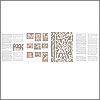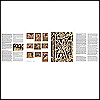Austrian Ceramics Today
Wretched humans looking down from a tile as if it were a medieval facade, but what is it that soars above their heads? Is it a saint? Is it God the Father? – No, it’s a hero of our age: Superman.
Wilfried Gerstel’s wall relief series “A Helper in Need” combines the tradition of medieval imagery with elements of comic-book culture, as well as delicate precision work in the molding of miniature ornamental elements, humans and grotesque figures from clay with computer-generated images. The series, which comprises nine single pictures, makes Superman fly again and tells his story.
Visually and in their crafting, the two spheres represented here are markedly different: the medieval scenes are molded in raw clay, which the artist explains as follows: “My work is inspired by Romanesque sculpture whose honesty and expressiveness has always moved me.
The choice of unglazed , naked clay is an expression of this reduction to the elementary, as any glazing would be a distraction from the archetypal and essential.”
Superman, by contrast, wears his blue-and-red superhero outfit which makes him immediately identifiable. This was achieved by applying a printed foil to the fired clay, with the whole tile then fired again at a low temperature – a modern rendering of a modern superhero, as compared to naked, unfired clay, the form of representation of a long-past view of the world.
As, back in the Middle Ages, pictures and architecture had a narrative function and served to convey religious doctrine to the illiterate simple people, so the comic-book literature of our time can be called popular reading.
Nevertheless, the clash of the two narrative modes creates a strong contrast. For it is not just Superman and ordinary humans that are juxtaposed here, but two different ages of mankind. 20th century “fast-food” books are brought together with the medieval religious indoctrination: what both languages have in common is a sense of strong gestures.
Presumably, the supermen and women of the Middle Ages were saints, endowed with “superhuman” powers, worthy of adoration, revered and prayed to for help, and stylized into icons, just as the icons of our epoch are part of the popular culture of the 20th and 21st centuries.
The historian Pieter M. Judson sees the following intent in these quotations of medieval art. “He (Gerstel) thus challenges everything which perhaps must not be challenged. The language of the pious Middle Ages becomes a highly critical instrument of investigation used to explore contemporary human behaviors.”
On the first two tiles, Superman is introduced, followed by the hero’s “mission statement”. But then Superman starts ruminating, realizing that greed is rampant among the human race. And so he sets to work. The quotation of the sixth tile – “Pa knows that not all seeds come up, but he gives each a chance to grow” – is strongly reminiscent of Christian wording, a reference to some God-Father, which would make Superman God’s only begotten Son.
But he is soon assailed by doubt, as Judson aptly notes: “Isn’t it perhaps better to enjoy the sensual pleasures of human existence, than to have superpowers?”
Doubt is followed by resignation. The hero no longer believes that he can change anything.
The last tile shows Superman’s death. The hero dies without having brought redemption to the people, leaving mankind to its own devices: “The problem, Pa said, is Man.”
Katja Miksovsky, Curator for Glass and Ceramics at the MAK
(Museum of Applied Arts/Contemporary Art, Vienna)

Austrian Ceramics Today
Katja Miksovsky, Curator for Glass and Ceramics at the MAK
(Museum of Applied Arts/Contemporary Art, Vienna)






